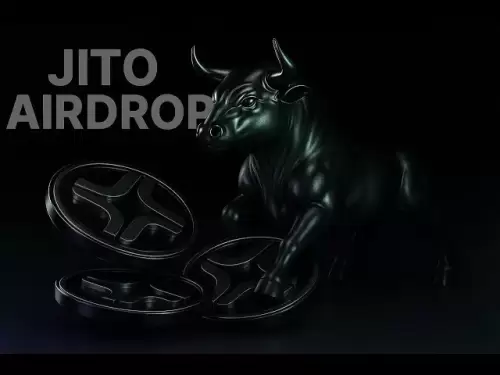 |
|
 |
|
 |
|
 |
|
 |
|
 |
|
 |
|
 |
|
 |
|
 |
|
 |
|
 |
|
 |
|
 |
|
 |
|
Cryptocurrency News Articles
From White Paper to Global Craze: The Evolution of Blockchain Technology and the Rise of Real-World Asset Tokenization
May 16, 2025 at 11:13 pm
In the past decade, blockchain technology has moved from a white paper to a global craze, then distilled practical logic from a hype wave

In the past decade, blockchain technology has moved from a white paper to a global craze, then distilled practical logic from a hype wave, returning from "on-chain games" to solving "real-world problems." A typical representative of this trend that is increasingly being bet on by more capital and institutions is RWA (Real World Assets Tokenization).
From the earliest Bitcoin and Ethereum, to the brief frenzy of NFTs, and now the rapidly advancing RWA, blockchain has always been answering one question: How to transform virtual technological advantages into financial value in reality?
Bitcoin's Revelation: The Ceiling of Technological Fundamentalism
In 2009, the emergence of Bitcoin sparked a global cryptocurrency wave. It challenged the existing financial system with a completely chain-born decentralized model, attracting the faith of countless geeks and anti-mainstreamers. However, problems quickly surfaced: low transaction efficiency, high energy consumption, unclear value anchoring, and a singular application scenario. More importantly, it is too disconnected from the asset and value system of the real world.
Bitcoin, as a "digital gold", is destined to exist more as a speculative value target rather than a true medium for the circulation of production factors. Especially in areas such as cross-chain operations, off-chain payments, and connections with fiat currency, it relies heavily on centralized exchanges and stablecoin systems, which makes the so-called "decentralized security" structurally fragile.
These issues have laid the groundwork for the emergence of RWA, hinting that "real needs have not yet been met".
NFT Transition: The embryonic form of tokenization, but difficult to bear financial functions.
The explosion of NFTs showed us for the first time that non-fungible assets in the real world can be encrypted, tokenized, and traded. CryptoPunks, BAYC, virtual land—these NFTs based on the Ethereum ERC-721 standard are no longer "purely chain-born assets", but are contrasted with artworks, intellectual property, and other values.
However, the limitations of NFTs are also obvious:
Most image and video storage is off-chain, posing a technical risk of disconnection;
Market speculation is heavy, and value anchoring remains unclear;
Transaction infrastructure relies on centralized platforms, lacking a sustainable user base in the long term;
Under the existing legal and regulatory framework, the boundaries of NFT property rights are vague, making it difficult to form a compliant circulation logic.
Although NFTs have opened a door for the concept of RWA, they cannot truly solve the systemic problem of "real assets being brought on-chain".
The emergence of RWA: Bringing blockchain into the 'main subject' of the real world.
Unlike Bitcoin or NFTs, RWA is not about "creating a coin", but about bringing existing valuable assets in the real world on-chain and tokenizing them. Whether it is real estate, bonds, accounts receivable, copyrights, energy, or even data assets, the core of RWA is to enable traditional assets to be operated "on-chain", achieving efficiency improvement and market expansion.
Core advantages:
Breaking the isolation of traditional finance.: By standardizing different assets through tokens, we can lower transaction barriers;
Enhancing liquidity: Turning originally non-standard, hard-to-circulate assets into globally tradable "digital shares";
Increasing trust and transparency: On-chain data is public and traceable, reducing intermediary and audit costs;
Promoting financial inclusivity: Global users can participate in high-value asset transactions with a low threshold, disrupting the monopoly of traditional institutions.
The actual promoters of these types of assets include traditional financial giants such as BlackRock and Franklin Templeton, who have begun to tokenize bonds, government bonds, and other assets on-chain, and run models in real markets. Moreover, AI investment research platforms such as Mlion.ai have also begun to extract key data from the RWA track, supported by intelligent strategy diagrams, assisting users in identifying the real value and trading logic of assets in emerging markets.
The problems still exist: The authenticity of underlying assets and regulatory compliance are hard injuries.
Although RWA has broad prospects, it is not without challenges, especially regarding the authenticity of assets, legal protection, and the implementation of on-chain governance mechanisms.
How to confirm the real existence of the physical assets represented by on-chain tokens?
How to handle legal actions such as asset ownership disputes and debt transfer?
How to construct a compliance trading framework under a multinational legal environment?
How to custody, clear, and settle on-chain assets to avoid pseudo-DeFi?
Currently, whether it is the on-chain evidence standards, regulatory reporting requirements, or tax audits and anti-money laundering systems, RWA faces extremely high demands. This is a significant reason why RWA needs the integration of technology, institutions, and financial logic.
China's reality: Technological readiness VS Regulatory implementation.
In China, to promote the healthy development of RWA, the following key
Disclaimer:info@kdj.com
The information provided is not trading advice. kdj.com does not assume any responsibility for any investments made based on the information provided in this article. Cryptocurrencies are highly volatile and it is highly recommended that you invest with caution after thorough research!
If you believe that the content used on this website infringes your copyright, please contact us immediately (info@kdj.com) and we will delete it promptly.





























































